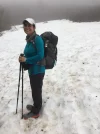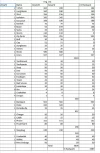- Time of past OR future Camino
- CF 2024
Ok, I fully expect this to be controversial, and it arises from the current forum thread about pack weight.
First, my premise. For those of us who have previously walked the Camino, and especially longtime backpackers/hikers, I think we have a duty to dispense straightforward, unvarnished advice. Now, if you are a veteran Pilgrim or backpacker, you know what you can do, and what constitutes comfort in terms of pack weight. I'm speaking now of the neophyte who is undertaking the Camino and it is the first time that person has walked an extended distance, and carried a pack. That is the person who is in most need of sound advice.
When I read responses to newbies questions about pack weight, I can't help but notice most of them are of the "just do what works for you" genre. Sorry, that's not good enough. The newbies don't know what works. So, when they hear about the so-called 10% of body weight "rule", that probably sounds reasonable. But it's not. And here's where I imagine I am going to get hammered: No one, irrespective of your years of Camino/hiking/backpacking experience or physical condition needs to or should carry more than 15 lbs/7kgs--12 lbs is closer to the ideal in my rather opinionated view. A few more pounds on any given day I suppose is not a big deal, but extra pounds daily over the course of 4-6 weeks is a big deal. And while I can't prove this point with data, my years of wilderness backpacking and my two recent Caminos tell me that the weight on your back is directly correlated to your ability and likelihood of completing the trek. Most veteran backpackers will have some formula where they have heard about the effect of each additional lb on your legs (mostly from the knee down) and feet. The sheer force that causes blisters or the strain on our knees, lower legs and feet is magnified by every pound on our backs.
I live in the mountains at about 8000 feet elevation. Most of the serious backpackers I know have their kit down to about 9 lbs exclusive of water and food. And, that, of course, includes cooking gear, tent, pad and sleeping bag--three of those four things are not required on the Camino. A sleeping bag in not necessary in the summer months, although having one might make you feel better, but from June through September it's just not needed. So, if serious long distance thru hikers have their basic kit down around 10 lbs, it seems like Camino Pilgrims could approach that weight. On a side note, I will avoid talking about the over-abundance of caution regarding carrying water. I read on this forum regularly about people carrying two liters! Two liters weight is 4.5 lbs. Yes, there are a couple days when there is a dearth of bars and one might be 10 miles between water. But 95% of the time, it's one village/bar after another. But this water thing is not the point of my post. I will just say that inasmuch as on the Camino we are walking through a man-made landscape with it's attendant commerce, this idea of constantly being "hydrated" necessitating carrying water, is in my I'm sure to be controversial experience way overdone. Now, of course, there are exceptions. On a scorching day, more water will be required I suppose, but overall there is simply no need to carry 2-4 lbs of water. It just ain't necessary. If our feet and knees could talk, they would probably tell us that.
It has been heartening to see that over the last few years on the forum, trail shoes/trainers/running shoes have pretty much displaced conventional hiking boots, which is another topic some of our veteran members have successfully weighed in on. But, what we put on our feet is so personal and unique to the specific body, that the "whatever works for you" approach is probably right. If you have comfortable shoes that you know from experience will work, well that's good enough. But pack weight is a different story. Again, and blast away at me for my seemingly dogmatic opinions, but I'll say it again--no one needs to or should carry more than 15 lbs, and getting it down to 12 should be the goal.
To make my earlier point about unvarnished advice, the opinions I have expressed here derive from almost 50 years of wildnerness backpacking, and, most recently, the Camino. By the way, Camino walking/trekking has totally replaced wilderness backpacking for me. To paraphrase the words of the great Native American and Warrior Chief Joseph, "never no more shall I sleep in the ground, even in a tent."
Finally, these comments relate specifically to advising brand new Pilgrims without previous backpacking experience. For those experienced on this forum, and there are many, you already know what your limitations are, and you pack accordingly.
Ok, I am prepared to accept incoming fire regarding this post.
First, my premise. For those of us who have previously walked the Camino, and especially longtime backpackers/hikers, I think we have a duty to dispense straightforward, unvarnished advice. Now, if you are a veteran Pilgrim or backpacker, you know what you can do, and what constitutes comfort in terms of pack weight. I'm speaking now of the neophyte who is undertaking the Camino and it is the first time that person has walked an extended distance, and carried a pack. That is the person who is in most need of sound advice.
When I read responses to newbies questions about pack weight, I can't help but notice most of them are of the "just do what works for you" genre. Sorry, that's not good enough. The newbies don't know what works. So, when they hear about the so-called 10% of body weight "rule", that probably sounds reasonable. But it's not. And here's where I imagine I am going to get hammered: No one, irrespective of your years of Camino/hiking/backpacking experience or physical condition needs to or should carry more than 15 lbs/7kgs--12 lbs is closer to the ideal in my rather opinionated view. A few more pounds on any given day I suppose is not a big deal, but extra pounds daily over the course of 4-6 weeks is a big deal. And while I can't prove this point with data, my years of wilderness backpacking and my two recent Caminos tell me that the weight on your back is directly correlated to your ability and likelihood of completing the trek. Most veteran backpackers will have some formula where they have heard about the effect of each additional lb on your legs (mostly from the knee down) and feet. The sheer force that causes blisters or the strain on our knees, lower legs and feet is magnified by every pound on our backs.
I live in the mountains at about 8000 feet elevation. Most of the serious backpackers I know have their kit down to about 9 lbs exclusive of water and food. And, that, of course, includes cooking gear, tent, pad and sleeping bag--three of those four things are not required on the Camino. A sleeping bag in not necessary in the summer months, although having one might make you feel better, but from June through September it's just not needed. So, if serious long distance thru hikers have their basic kit down around 10 lbs, it seems like Camino Pilgrims could approach that weight. On a side note, I will avoid talking about the over-abundance of caution regarding carrying water. I read on this forum regularly about people carrying two liters! Two liters weight is 4.5 lbs. Yes, there are a couple days when there is a dearth of bars and one might be 10 miles between water. But 95% of the time, it's one village/bar after another. But this water thing is not the point of my post. I will just say that inasmuch as on the Camino we are walking through a man-made landscape with it's attendant commerce, this idea of constantly being "hydrated" necessitating carrying water, is in my I'm sure to be controversial experience way overdone. Now, of course, there are exceptions. On a scorching day, more water will be required I suppose, but overall there is simply no need to carry 2-4 lbs of water. It just ain't necessary. If our feet and knees could talk, they would probably tell us that.
It has been heartening to see that over the last few years on the forum, trail shoes/trainers/running shoes have pretty much displaced conventional hiking boots, which is another topic some of our veteran members have successfully weighed in on. But, what we put on our feet is so personal and unique to the specific body, that the "whatever works for you" approach is probably right. If you have comfortable shoes that you know from experience will work, well that's good enough. But pack weight is a different story. Again, and blast away at me for my seemingly dogmatic opinions, but I'll say it again--no one needs to or should carry more than 15 lbs, and getting it down to 12 should be the goal.
To make my earlier point about unvarnished advice, the opinions I have expressed here derive from almost 50 years of wildnerness backpacking, and, most recently, the Camino. By the way, Camino walking/trekking has totally replaced wilderness backpacking for me. To paraphrase the words of the great Native American and Warrior Chief Joseph, "never no more shall I sleep in the ground, even in a tent."
Finally, these comments relate specifically to advising brand new Pilgrims without previous backpacking experience. For those experienced on this forum, and there are many, you already know what your limitations are, and you pack accordingly.
Ok, I am prepared to accept incoming fire regarding this post.
























